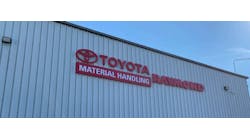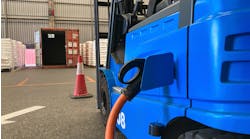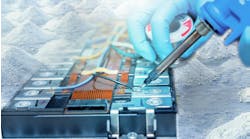"You go to war with the army you have, not the army you might want or wish to have at a later time."—Donald Rumsfeld, former U.S. Secretary of Defense.
Bash Rummy all you want, but his statement is fact. I'll throw in another precept the military lives by: "Necessity is the mother of invention." Military logisticians are always inventing to get more service from the assets they have in the field. Civilian logistics managers have the military to thank for some of warehousing's best tools: barcoding and radio frequency identification, to name two.
Well, the military is developing another material handling innovation and this time it involves that crusty old soldier, the lift truck.
The US Army Reserve National Guard based in Grand Forks, North Dakota, worked with ePower Synergies, Cordova, IL (www.epowersynergies.com) and the University of North Dakota Energy and Environmental Research Center to build a hybrid electric fuel cell lift truck. Part of this project involves a reformer system that can convert jet fuel into hydrogen. In keeping with the philosophy of using what you have, the idea is to go into the field of battle with one fuel to power both your fighters and your material handlers.
How could such a specialized application benefit the private sector? The Army Reserve National Guard Base in Grand Forks moves a lot of material, inside and outside, in cold and hot weather. Civilian battery powered lift trucks don't like these extremes.
"We decided we wanted a unit that could operate outdoors and indoors and compete against a diesel or propane truck," says Bruce Wood, president and CEO of ePower Synergies.
The team started by sourcing its main component from Scotland, a Hyster 5,000 pound capacity pneumatic-tire lift trucks equipped with the European-standard 80volt drive system. For the fuel cell, the team worked with General Hydrogen to develop a special power pack to accommodate an 80volt system. The U.S. standard is 36-48 volts.
Military material handlers have been using the hydrogen-powered lift truck since mid 2006. It keeps on working, without power loss. Operators refuel as needed. They pull up to the refueling station, lock the nozzle onto the port of the lift truck, and five minutes later they're ready to continue what they were doing.
These vehicles are a combination of fuel cells and ultracapacitors. Ultracapacitors act like a battery in taking an external charge. However they charge and discharge faster than a standard battery. They provide backup power to the fuel cell, under the same principal as a hybrid automobile.
Wood says that as this technology enters civilian applications, lift trucks could have all three power sources working in concert. The main source of power would be the fuel cell, a battery to provide long-term energy storage, and ultracapacitors for short-term energy bursts. A controller will source and distribute the power as conditions demand.
One of the bugs that still needs to be worked out on the civilian side is the hydrogen infrastructure. It's true, we probably won't see fuel-cell-powered cars stopping at corner hydrogen stations for at least 15 years, but as you'll read in this month's fuel cell feature ("Fuel Cells: From Fantasy to Reality," on page 16), installing hydrogen fueling stations in the appropriate distribution environments is being done today—at a cost of $3-$5 per kilogram, Wood reports.
"If I look at the economy of using that hydrogen in a lift truck, it's about three times as efficient as propane," he says. "That's no longer an issue. And there are plenty of companies producing hydrogen."
In the spirit of making best use of the resources you have, hydrogen can come from a number of energy sources, so you may some day be able to tap those closest to your plant or distribution center. Let the basic training begin.
Tom Andel has written about and been involved in the material handling industry for more than 26 years.



